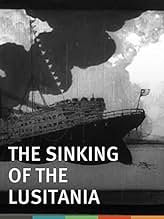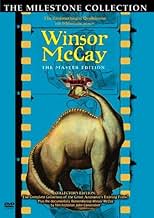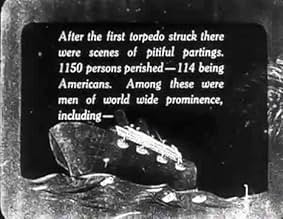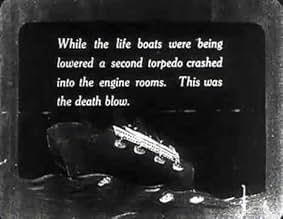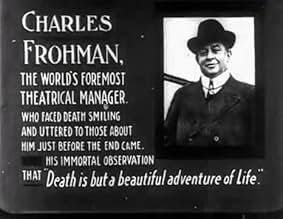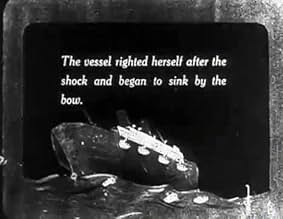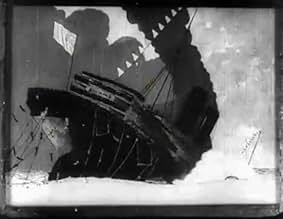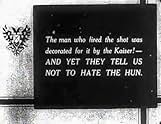PUNTUACIÓN EN IMDb
6,8/10
1,3 mil
TU PUNTUACIÓN
Añade un argumento en tu idiomaAn animated dramatization of the notorious World War I German torpedoing of the ocean liner, Lusitania.An animated dramatization of the notorious World War I German torpedoing of the ocean liner, Lusitania.An animated dramatization of the notorious World War I German torpedoing of the ocean liner, Lusitania.
- Dirección
- Guión
- Reparto principal
- Premios
- 1 premio en total
Reseñas destacadas
Premiering almost three years to the month of the German submarine attack on a passenger ship, Winsor McCay's laborious effort to bring a dramatic slant to one of the United States' momentus events during the second year of the Great War resulted in the groundbreaking animated cartoon May 1918's "The Sinking of the Lusitania." The 12-minute film was not only the longest animation up to that time, but is the earliest surviving cartoon of a serious and dramatic nature.
McCay, an editorial cartoonist for the William Randolph Hearst newspaper chain, was a animated hobbyist in his spare time. He was bothered by Hearst's demands that he draw only anti-war, anti-British cartoons since the publisher was an ardent isolationist ever since the war began in 1914. The German submarine attack on the British ocean liner Lusitania carrying American passengers on May 7, 1915, especially rankled McCay, sparking a project of illustrating the sinking in animated form.
For 22 months, he along with two other illustrators composed over 25,000 drawings in their spare time and using McCay's own money. The trio used the fairly new animated technology of cel animation, using sheets of cellulose acetate to draw the movements of the ship and sub while retaining the static layer underneath, the first time McCay had ever used the process. Despite the time-saving operation, the moving cartoon still took an inordinate amount of time to create. To produce eight seconds of film, McCay claimed it took eight weeks to draw and film.
Jewel Productions, a film distribution company, paid the highest price at that time for a one-reeler for its rights. The company claimed the cartoon was "the world's only record of the crime that shocked humanity" since there weren't any cameras on board the Lusitania to record the torpedo hits. The propaganda value when it was shown during the summer of 1918, although emotional, was limited since American troops were already heavily involved in the European battles. But the "Lusitania" would serve as an example to the effectiveness in using animation for propaganda purposes, especially when World War Two rolled around 25 years later.
McCay, an editorial cartoonist for the William Randolph Hearst newspaper chain, was a animated hobbyist in his spare time. He was bothered by Hearst's demands that he draw only anti-war, anti-British cartoons since the publisher was an ardent isolationist ever since the war began in 1914. The German submarine attack on the British ocean liner Lusitania carrying American passengers on May 7, 1915, especially rankled McCay, sparking a project of illustrating the sinking in animated form.
For 22 months, he along with two other illustrators composed over 25,000 drawings in their spare time and using McCay's own money. The trio used the fairly new animated technology of cel animation, using sheets of cellulose acetate to draw the movements of the ship and sub while retaining the static layer underneath, the first time McCay had ever used the process. Despite the time-saving operation, the moving cartoon still took an inordinate amount of time to create. To produce eight seconds of film, McCay claimed it took eight weeks to draw and film.
Jewel Productions, a film distribution company, paid the highest price at that time for a one-reeler for its rights. The company claimed the cartoon was "the world's only record of the crime that shocked humanity" since there weren't any cameras on board the Lusitania to record the torpedo hits. The propaganda value when it was shown during the summer of 1918, although emotional, was limited since American troops were already heavily involved in the European battles. But the "Lusitania" would serve as an example to the effectiveness in using animation for propaganda purposes, especially when World War Two rolled around 25 years later.
Animation pioneer Winsor McCay applies all his considerable skills in this feature, creating a detailed and memorable account of the sinking of the Lusitania. The technique still looks quite good, and it really brings the events to life. It must have been quite effective in its time.
There are lots of details that not only are carefully rendered, but that also are used effectively to add to the overall effect. It both communicates the factual details and brings out the horrors of the situation as well as any short feature could do. The events seem to be depicted with great care and accuracy, and only the strongly-worded commentary on a few of title cards reveals the creator's viewpoint. (It doesn't detract from the fine quality of this movie, but it's always unfortunate when entire nations of people are condemned for the barbarous or irresponsible actions of some of their leaders. It's understandable, of course, but unfortunate.)
The Lusitania sinking was one of the most notorious events in a century that saw more than enough of them. This carefully crafted movie does its job in preserving both what happened and the response to it.
There are lots of details that not only are carefully rendered, but that also are used effectively to add to the overall effect. It both communicates the factual details and brings out the horrors of the situation as well as any short feature could do. The events seem to be depicted with great care and accuracy, and only the strongly-worded commentary on a few of title cards reveals the creator's viewpoint. (It doesn't detract from the fine quality of this movie, but it's always unfortunate when entire nations of people are condemned for the barbarous or irresponsible actions of some of their leaders. It's understandable, of course, but unfortunate.)
The Lusitania sinking was one of the most notorious events in a century that saw more than enough of them. This carefully crafted movie does its job in preserving both what happened and the response to it.
The Sinking of the Lusitania (1918)
*** (out of 4)
This WWI propaganda piece is from Winsor McCay, the famed animator who decided to use his skills and so something quite different. This film documents the German attack on the Lusitania ship, which was carrying 2000 people when it was hit by a couple torpedoes and sank fifteen-minutes later. The film clocks in at twelve-minutes and the animation is used to show what happened and then we're given actual footage talking about how evil Germany is and we also have a brief tribute to some of the men who were lost. This is a fairly interesting film on many levels but the biggest is because of all the fire and passion that McCay brings to the material. There's no doubt that this was a very personal film to him and he clearly makes his feelings known by attacking Germany on pretty much every level. There's no question that the gloves are off as the title cards are quite damning to the actions that were done that day. The animation of the boat sinking is quite simple on one hand but I'd argue there are still some very striking moments here. I think the greatest are the shots of the ship and the smoke coming from it. The long, complete shots of the ship are quite striking in their animated form and just watch the way that the smoke comes off of it. The previously mentioned tribute shows some of the famous people that died on the ship, which was somewhat questionable and especially since none of the other victims are even mentioned and no tribute is given to them. With that said, this is still very much worth seeing just for the passion that it displays.
*** (out of 4)
This WWI propaganda piece is from Winsor McCay, the famed animator who decided to use his skills and so something quite different. This film documents the German attack on the Lusitania ship, which was carrying 2000 people when it was hit by a couple torpedoes and sank fifteen-minutes later. The film clocks in at twelve-minutes and the animation is used to show what happened and then we're given actual footage talking about how evil Germany is and we also have a brief tribute to some of the men who were lost. This is a fairly interesting film on many levels but the biggest is because of all the fire and passion that McCay brings to the material. There's no doubt that this was a very personal film to him and he clearly makes his feelings known by attacking Germany on pretty much every level. There's no question that the gloves are off as the title cards are quite damning to the actions that were done that day. The animation of the boat sinking is quite simple on one hand but I'd argue there are still some very striking moments here. I think the greatest are the shots of the ship and the smoke coming from it. The long, complete shots of the ship are quite striking in their animated form and just watch the way that the smoke comes off of it. The previously mentioned tribute shows some of the famous people that died on the ship, which was somewhat questionable and especially since none of the other victims are even mentioned and no tribute is given to them. With that said, this is still very much worth seeing just for the passion that it displays.
From Winsor McCay, the revolutionary animation pioneer and director of the charming classic "Gertie the Dinosaur" comes a much darker animated tale. This film recounts the tragic striking and sinking of the Lusitania which took away over 1000 lives. This film is highly respectful in execution, and it certainly isn't what you would expect from McCay, who normally crafted extremely funny and enjoyable animations rather than heartbreaking dramas. But, although its execution is much different than any other silent drama on the subject could be, it is highly effective and powerful, not to mention well made! The animation is wonderfully done, and doesn't look too "cartoony" for the depressing subject matter. McCay creates haunting and slightly propagandic images with this invention, images that wouldn't have been successfully captured on a 1918 movie set.
Animation historians must view this film immediately, but I suppose if you can find one McCay cartoon you can find them all - they're compiled on the 'Animation Legend' video and DVD. 'Lusitania' is the film where McCay tries to escape the caricatural confines of the animated picture to produce a serious and moving film, and damn, he succeeds. The meticulous care which he put into the thousands of drawings necessary for this short cartoon meant that by the time it was finished, it was barely topical and WWI was over, leaving its calls for vengeance somewhat stranded. However, as a study of technique it is perhaps unsurpassed. McCay's animation has a dimensionality which is worlds apart from the character animation of Koko the Klown or Felix the Cat, perhaps a deliberate differentiation from such gentle entertainments. The grim monochrome images of the Lusitania's stern raised in the air while hundreds of people leap to their deaths while remind most audiences of shots from James Cameron's 'Titanic'. While the barely-concealed rage and maudlin tributes to the famous noblemen who died in the sinking (as opposed the penniless plebs who we can afford to forget) now appear unpalatably heavy-handed, the elegant curls of smoke from the stricken vessel are simply powerful cinematic touches which seal McCay's reputation as one of the great film artists of the silent era. If only he, and not Disney, had become the template for the future of American animation...
¿Sabías que...?
- CuriosidadesAs First Lord of the Admiralty Winston Churchill allowed civilian ships to transport war munitions for the Western Front. He prevented German U-Boats from searching the ships by illegally arming merchant ships, introducing Q-ships with concealed deck guns, and by ordering merchant captains to evade and submarines that surfaced.
- PifiasThe German submarine fired only one torpedo, not two. The second explosion originated from within the ship near where the torpedo hit. The cause still remains uncertain. It has been widely speculated that the second explosion was caused by war munitions the ship was illegally transporting for the Western Front.
- ConexionesEdited into Los comienzos de la animación (1995)
Selecciones populares
Inicia sesión para calificar y añadir a tu lista para recibir recomendaciones personalizadas
Detalles
- Duración12 minutos
- Color
- Mezcla de sonido
- Relación de aspecto
- 1.33 : 1
Contribuir a esta página
Sugerir un cambio o añadir el contenido que falta

Principal laguna de datos
By what name was El hundimiento del Lusitania (1918) officially released in Canada in English?
Responde
